While many believe that Pashmina shawls are banned, this is actually not true. It is shahtoosh shawls, which come from the chiru goat (declared endangered under CITES), that received a ban. Pashmina is cruelty-free and permitted to wear whenever one wishes
The regality of Kashmiri Pashmina Shawls dates back to the 14th century. It was when Sufi saint Mir Syed Ali Hamdani traveled to Kashmir from Persia along with 700 skilled artisans. He made the then king start a factory to process and manufacture wraps and other wearables from this luxury fibre. Since then, the skill of Pashmina making and selling enjoyed purity and originality. But later when industrialization took over, a few vendors planned to deceive customers and sell wool or other adulterated fabrics by the name of Pashmina.
Because innocent customers didn’t know the difference between original and fake, they fell for the fake promises made by vendors; they purchased fake Pashminas in place of original ones. The problem further enhanced when the actual artisans of Pashmina making started to suffer. For this reason, the team of Pashm, along with an experienced Kashmiri Pashmina vendor, endeavor to regain the lost glory of original Pashmina making. In addition to this, we set out to find why are Pashmina shawls banned, if at all.
Also read: Things to know before you buy a real Pashmina
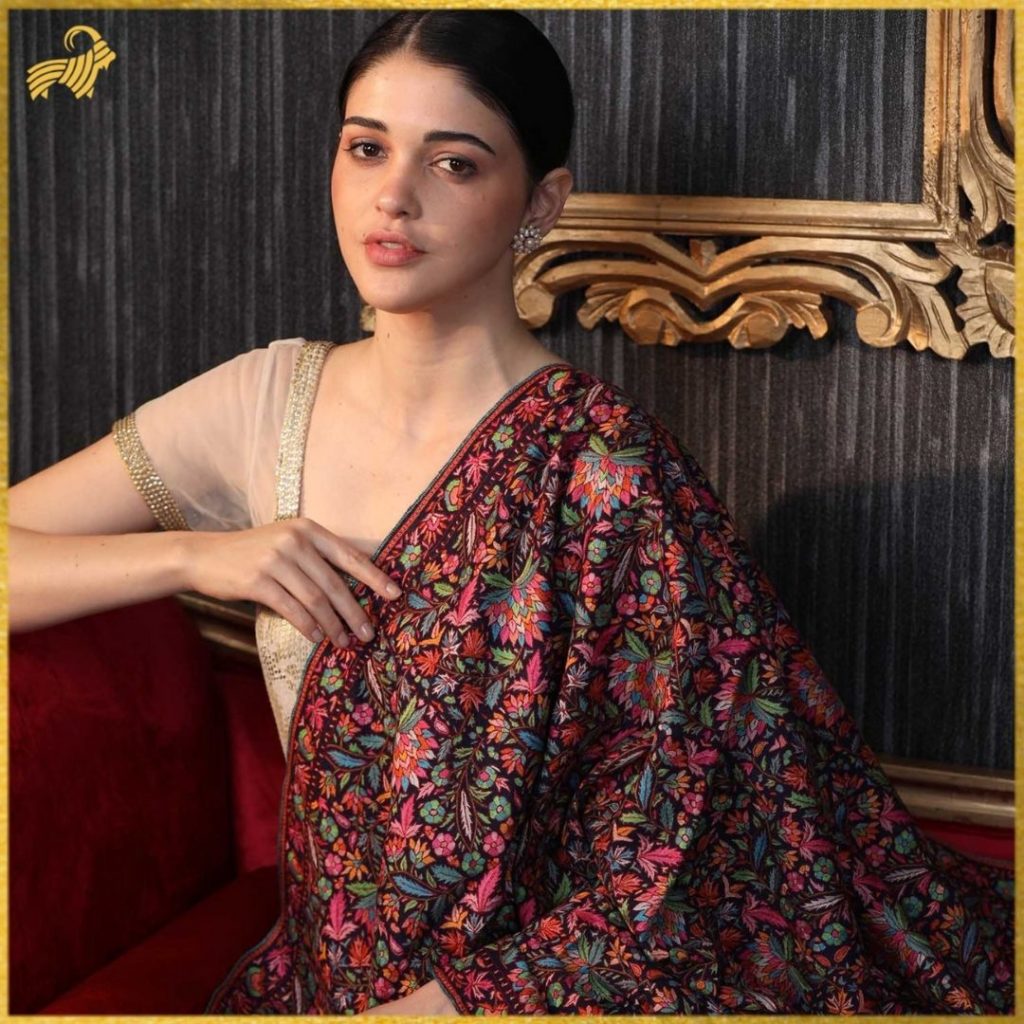
Understanding Pashmina: What Makes It So Special
Pashmina is the art where artisans transform Cashmere wool to luxury shawls, scarves. It is often called "soft gold". The luxurious Cashmere comes from the fine undercoat of the Changthangi goats, native to the high-altitude regions of the Himalayas, particularly in Ladakh and Kashmir. The unique climate of this region, with its extreme cold, allows these goats to grow an incredibly soft and warm underlayer of wool. Herders carefully hand-comb it every spring.
What sets Cashmere apart from other types of wool is its exceptional softness and fineness. The fibers are so delicate because they are six times finer than human hair. This fineness gives Pashmina its signature lightweight feel, making it incredibly soft against the skin, yet warm enough to provide insulation in cold weather. Unlike synthetic materials, Pashmina is also naturally breathable, allowing for comfort across a range of temperatures.
The craftsmanship involved in creating Pashmina shawls adds to their uniqueness. Traditional artisans spin the delicate fibers by hand and weave them into fabric using age-old techniques passed down through generations. This process is time-consuming and requires immense skill, but the result is a product that embodies both luxury and cultural heritage.
In addition to its softness and warmth, Pashmina is famous for its natural sheen and ability to take on dyes beautifully, resulting in vibrant, long-lasting colors. These qualities, combined with its cultural significance and the artisanal craftsmanship involved in its production, make Pashmina an exceptional and highly sought-after material, celebrated for its timeless elegance and unmatched quality.
How is Pashmina acquired?
Light, downy, and sensuous to touch, the word Pashmina in itself sounds luxurious. And why shouldn’t it be? After all, it is the 14000 feet high mountain range of Ladakh, where the Changthangi goat fights the severe winter season. It is a coat of Pashmina over its underbelly which protects it from the freezing weather. At the onset of summer, the goat rubs itself with shrubs, rocks, barbed wires, leaving this delicate and extremely fine treasure of fibre. Herders collect it and artisans weave it into majestic Pashmina shawls, wraps, or other regal ensembles or accessories.
How meticulous is the process of transforming the adulterated fibre of the Pashmina into a pure fabric. The collection from dangerous high altitude places, the cleaning, spinning, weaving, dyeing and finally designing it into the specified silhouette; all the steps toward making a Pashmina special requires huge skill and deftness. Such a special craft required special attention. And our quest to explore this wonderful craft gave surprising results. We went deep into the process of making a Pashmina with an artisan, who associates with this craft for more than 50 years now. Ghulam Nabi - a patron of the heritage Pashmina art whose sorrowful eyes narrate the tale of how his skill lost to fake and cheap copies of the original craft.

Our journey to Pashmina shawls
We took a trip through the narrow streets of the downtown area of Srinagar, the heart of the Kashmir valley. Finally, we reached a place where every traditional craft of the valley which includes Copperware, Paper Mache, silverware, and others had its own shops where the best-skilled artists worked. Amongst all of these matchbox-sized shops, Ghulam Nabi owned a larger shop; he sold his Pashmina shawls there but manufactured them at home.
We entered his shop and introduced ourselves, and asked him if he could give us some of his time. We wished he could narrate the legends of the original Kashmiri Pashmina and how he stepped into its making. But since the downtown area is filled with hustle and bustle of a typical marketplace, we got an invitation to his home the next day. We left his shop but our eyes couldn’t miss the masterpieces that they captured in this short period of time. In just a few minutes, we had perhaps witnessed all the colours and all the patterns that the valley is world-famous for, and that ever existed. And we knew one thing for sure, we had come to the right destination.
Also read: 500 years of timeless fashion - Pure Pashmina
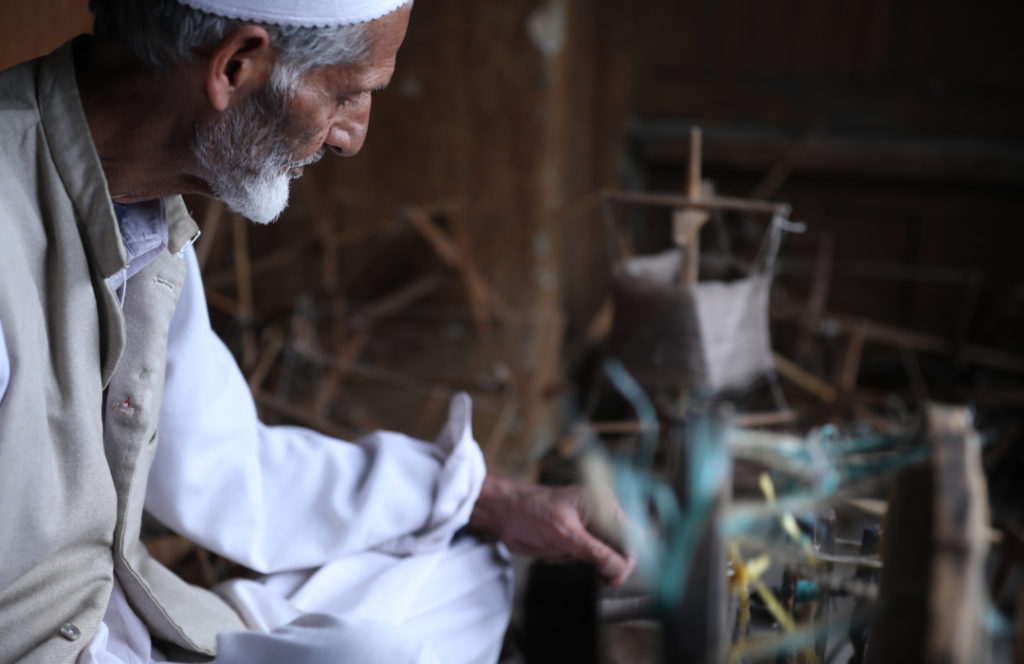
The night before
Our team spent the night in a local hotel room, excited about what was going to happen the other day. The next day, early in the morning, we reached the place where Ghulam Nabi had invited us to. Remembering the treasured collections we had seen yesterday, all of us expected a large showroom. We imagined around at least a hundred people working with him. Instead, we were surprised to see a small, not-so-well-lit room and four women working on four different pieces, over a charkha.
We all sat together, had a cup of tea, and then came to the main point of discussion. What is Pashmina, where it came from, how is it processed, and is there a compromise on the quality of Pashmina? At once Ghulam Nabi peeped out of the window, and his eyes seemed to be traveling in time. It seemed as if the 50 years he spent with this craft played right in front of him.
Word to Word with the artisan
“The craft is not at its best,'' said Ghulam Nabi who started his discussion with a complaint. We asked why the craft had lost itself with time, and he couldn’t stop but narrate the ordeal of his work. “When we started making Pashmina, our motive was to show Kashmir to the world; introduce its different crafts to those areas which had never even known what Kashmir was. But now, sellers just care about money. They want to give less and take more”, said Ghulam Nabi in a tone that sounded angrier.
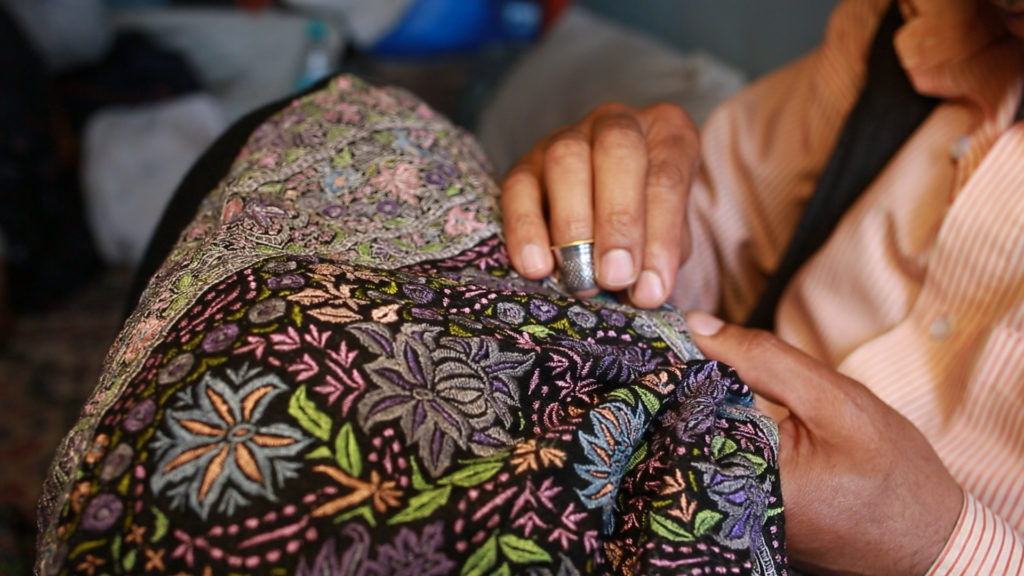
Gradually what we realized with his words was the same affliction that most of the crafts of Kashmir have been through. The craft of Pashmina was once at its zenith just because it was pure. But now, when people introduced cheaper copies of the same, adulterated with either wool or nylon, or dipped local woolen clothes in a fabric softener to give it a feel of Pashmina, the original craft started declining. Local vendors cheated customers by claiming fake Pashmina to be original. And innocent customers, who never before had seen or touched Pashmina believed it to be true. With time, there was a rumour that Pashmina is banned, as it leads to animal cruelty. But Ghulam Nabi had a different opinion. PASHMINA WAS NEVER BANNED!
Ban on Shahtoosh
While there is a mass confusion with regards to ban on a type of shawl, there certainly are reasons why it is so. We know that Pashmina is not banned. So there might be another type of shawl that received an international banned on account of animal cruelty?
It is Shahtoosh. Shahtoosh is banned. It's a tittle-tattle and is spread usually by the individuals who have vested interests in creating this confusion among the masses. Since Pashmina shawls are the best quality shawls, their low-quality produce get adversely affected due to more demand for the former.
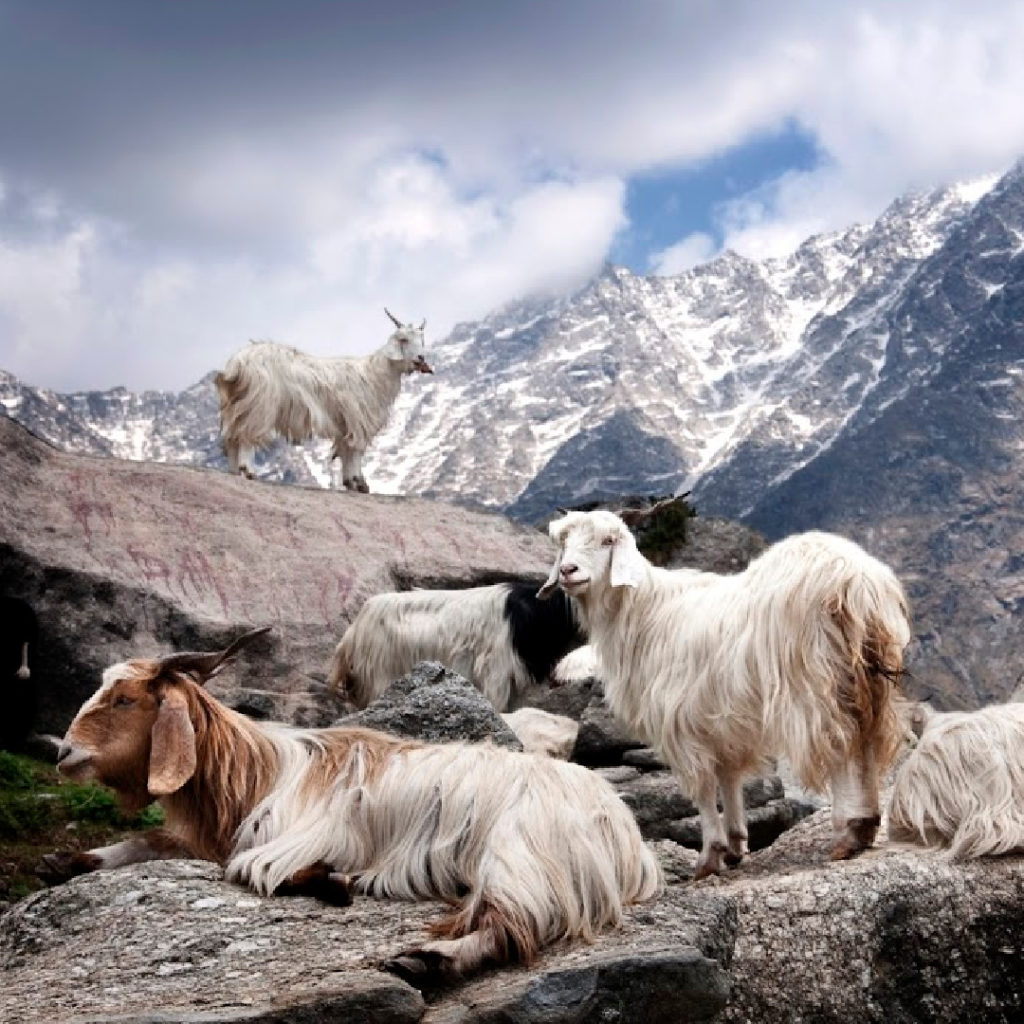
Which shawls are banned?
It's not completely a hoax that Kashmiri shawls are banned. But the category of shawls that received a ban in 1970's is Shahtoosh. Kashmiri wool has certain degrees according to their quality and finesse of the fibre artisans use to craft them. Shahtoosh is the top quality wool, obtained from Chiru goat. The fibre diameter is even less than that of Pashmina fibre. While Cashmere is 12-16 microns in diameter, Shahtoosh fibre is just 8 microns. This property leads it to be so fine that it can easily pass through a finger-ring. Many more differences between Pashmina and Shahtoosh follow:.
Why are Pashmina Shawls banned in India
There is no blanket ban on Pashmina shawls in India. Pashmina shawls are not banned in India; rather, they are a highly prized and culturally significant textile that has been produced and woven in the region of Kashmir for centuries.
However, there have been instances of counterfeit or mislabeled Pashmina products selling in the market. These can deceive consumers and undermine the authenticity of genuine Pashmina. To address this issue and protect the reputation of authentic Pashmina, the Indian government and various regulatory bodies have taken measures to promote and regulate the production and labeling of Pashmina products with the Geographical Indication (GI) Tag.
Difference between Pashmina shawls and Shahtoosh shawls
Pashmina and Shatoosh, both come from the hair of goats that live on high altitudes. But there are several commonalities between the two. Shahtoosh comes from an endangered species of goats called Chiru, or the Tibetan Antelope. The Convention on International Trade in Endangered Species (CITES) has listed the animal in the endangered species list..
Trappers forcefully obtain the fleece growing on the Tibetan Antelope by killing the animal and skinning the hair from its underbelly. The ban on Shahtoosh stemmed from animal cruelty and the decreasing number of Chiru goats. But unfortunately, a few traders still market Shahtoosh due to high demand from the west. The reason for this high demand is the finesse, lightweight, extreme warmth, and graceful look that Shahtoosh shawls lend to their wearer. A Shahtoosh shawl weighs less than half of a Pashmina shawl, and for this reason, it is too expensive.
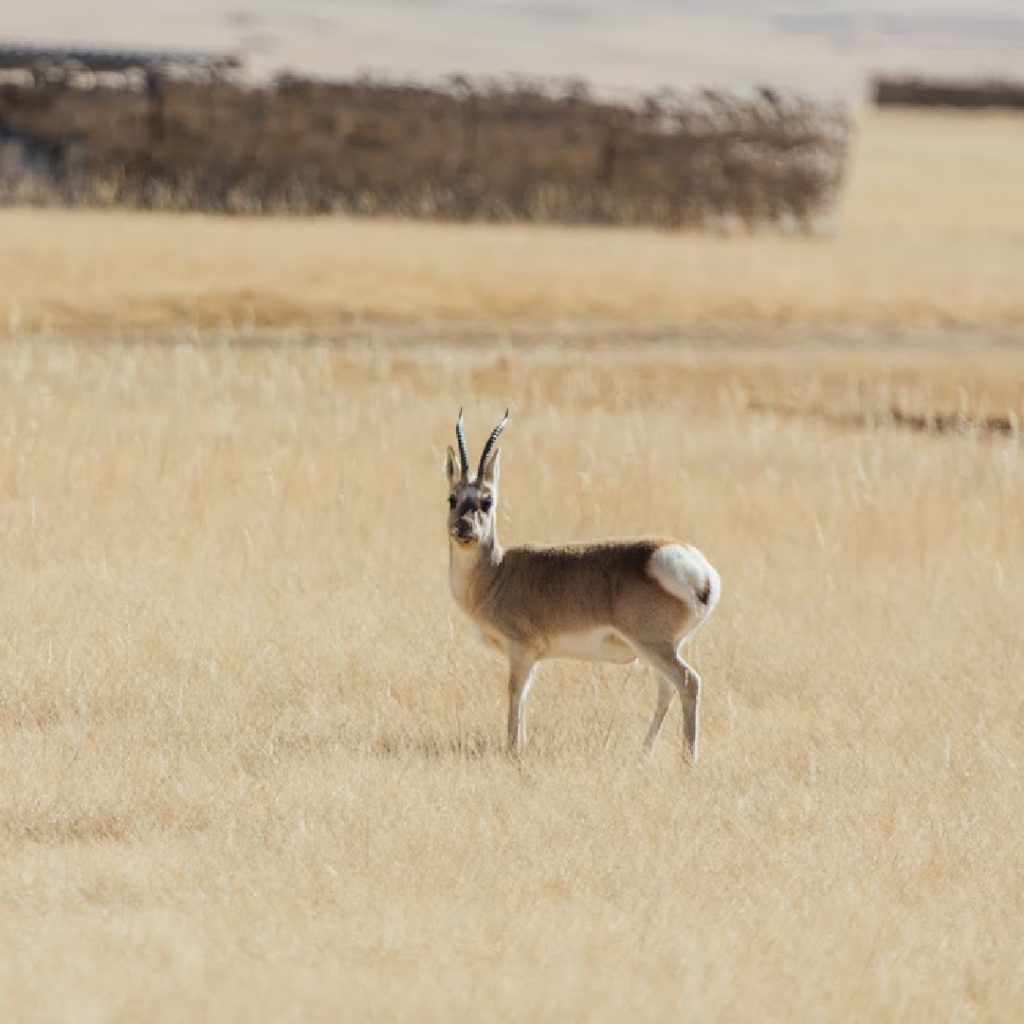
Shahtoosh is one of the world's finest wools and is indeed the choice of the elite.
Why isn't Pashmina banned?
Pashmina too is one of the best quality shawls, just not as fine as Shahtoosh. It comes from the fine raw Cashmere wool which grows on the underbelly of the Ladakhi Changthangi goat. The main reason why Pashmina is not banned is that the Changthangi goat is domesticated. Hence, herders do not need to kill it for wool. Herders ethically deal with Pashmina goats in hot summer, and they gently comb off the wool of their body.
Also read: What is Pashmina?
Pashmina shawls are soft, light, and beautiful when embellished with embroidery. For this reason, these are more expensive than ordinary sheep wool shawls.
The prices of Shahtoosh and Pashmina too differ. While a Shahtoosh shawl may even cost some 15-20 thousand dollars, the highest range of Pashmina will be 10 thousand dollars (US)
As responsible citizens, we should consider the ban on shahtoosh as a serious one. We should never try to buy or trade shahtoosh, even if it is too alluring. If you still have a question about why are Pashmina shawls banned, here is the answer to it. There is no ban on Pashmina, and we can have as many pieces of the same as we want.
Should we Buy Pashmina shawls?
As mentioned already in detail, Pashmina is not banned at all. And moreover, it is not even cruel. As many claim that hunters kill Pashmina goat in order to acquire its wool, the same is not true. It is this Changthangi goat on which the survival of its herders depends. So technically, if they kill their goat, they would be depriving themselves of their own livelihood, which would be foolish. When our team asked herders the same, they answered the same. Acquisition of Cashmere wool doesn't need the unethical killing of the goats.
Pashmina goat is a domestic animal and its herders don't need to look for it or hunt it to acquire wool. In fact, they professionally deal with it, using specialized tools, to comb off the hair gently.
It is this raw wool that weavers later weave over handlooms and introduce it in the market for the art admirers. The art of transforming Cashmere into luxury shawls and scarves is called Pashmina art. Artisans handcraft Pashmina shawls sustainably without using machines in the process. This makes them more responsible than cruel. The Pashmina industry is centuries old. Artisans have handcrafted Pashmina shawls for hundreds of years using the same technique.
Shahtoosh Shawls and Cruelty to the Chiru Antelope
As responsible citizens, we should consider the ban on Shahtoosh a serious one. We should never try to buy or trade-in shahtoosh, even if it is too alluring. It is this shawl that is cruel, and involves the killing of Chiru goats, as the goat is a wild animal. On the other hand, there is no ban on Pashmina, and we can have as many pieces of the same as we want. When we are investing in a luxury Pashmina shawl, we must know that this is a responsible purchase, and no blood has been shed to cover our shoulders, as is the case with many varieties of wool.
Now we are ready to face the question if anyone asks "Why is Pashmina Banned".
Explore Pashm's collection of Pure Pashmina Shawls and Wraps here...
The Global Demand for Ethical Pashmina
The global demand for ethical Pashmina has grown significantly. This is because consumers have become more aware of the importance of sustainability and ethical sourcing. Authentic Pashmina, that comes from the fine cashmere wool of the Changthangi goats, is famous for its luxurious softness, warmth, and lightweight nature. However, with the rise in demand, there has also been confusion about its production. And this leads some to wonder, "Why are Pashmina shawls banned?"
In reality, it is not Pashmina shawls that face a ban. The confusion often arises from the ban on Shahtoosh shawls. Artisans prepare shahtoosh shawls from the wool of the endangered Tibetan antelope. Unlike Shahtoosh, Pashmina has ethical source, with no harm done to animals. The goats naturally shed their wool during the molting season. Later, skilled artisans carefully collect and handcraft the wool into beautiful Pashmina shawls. This process is sustainable and supports the livelihoods of local communities in Kashmir and Ladakh.
As global awareness of ethical fashion grows, so does the demand for responsibly produced Pashmina. Consumers are increasingly seeking out Pashmina that is certified and traceable to ensure it meets ethical and environmental standards. This shift is encouraging producers to adopt more sustainable practices, from eco-friendly dyes to fair wages for artisans.
By choosing ethical Pashmina, consumers can enjoy the timeless elegance of these shawls while supporting a tradition that values both craftsmanship and sustainability. The question of "why are Pashmina shawls banned" serves as a reminder to stay informed and make responsible choices. These choices contribute to a more ethical and sustainable fashion industry.